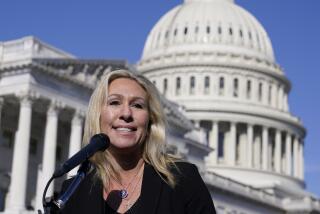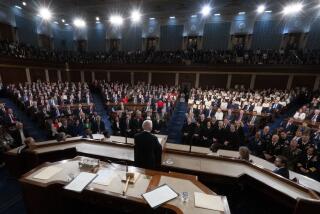Column: What we learned from the financial crisis — and what we’ve already forgotten
When calamity strikes — especially avoidable calamity — the human instinct is to look for the silver lining, often by calling the event a “teachable moment.”
Consider the most profound economic calamity of the last nine decades, the Great Recession triggered 10 years ago by the collapse of the investment bank Lehman Bros.
The recession suppressed American economic growth so severely that gross domestic product still has not recovered — and might never regain its lost output (by the reckoning of the Federal Reserve Bank of San Francisco). Because of the 2007 housing bust that prefigured the crash, median family finances also have not recovered to pre-crisis levels.
All of this prompts us to ask: What did we learn from this teachable moment? And have we already started to forget its lessons?
To ignore history is to ignore the wolf at the door.
— John le Carre
The most important teachings to be drawn from the crisis concerned the structural inequalities that had become embedded in the U.S. economy. As Emmanuel Saez of UC Berkeley has shown in collaboration with Thomas Piketty, the top 1% of income earners had captured more than half of all income growth from 1993 to 2007. The trend actually had begun in the mid-1970s, when gains from worker productivity ceased to be reflected in rank-and-file wage growth.
The struggle of working-class and middle-income Americans to keep up set the stage for the crisis. The housing boom was fueled in part by increasingly imprudent mortgage borrowing — loans unsupported by adequate income, offered by banks and other lenders on increasingly indulgent terms, and cash-out refinancings that shrank equity to razor-thin margins.
With wages stagnant, home equity appeared to be the only new source of current income for middle-class Americans. Home equity withdrawals accounted for more than 9% of disposable personal income just before the housing bubble burst, then “dried up overnight,” as Michael Calhoun of the Brookings Institution puts it, intensifying the post-crash economic slump.
RELATED: Employers will do almost anything to find workers--except pay them more »
Wall Street did its part to inflate this bubble by trading these threadbare mortgages as though they were gilt-edged, repackaging them in ways that obscured their riskiness. The profits to be made from this trading turbocharged the impulse to expand predatory lending. When the housing market cracked and the mortgages became gangrenous, the lenders and investment banks that held them on their books went down with them, notably Lehman Bros.
But the official response to the crisis failed to deal with the underlying problem: The teachable moment passed without its lesson being learned.
One reason for that may have been the severity of the crisis itself. Among its aspects that may already be forgotten was the level of fear that gripped the financial markets and political leaders, and the extent to which the response was a combination of improvisation and inadvertence.
“I just remember thinking, you know, Armageddon,” former Sen. Mel Martinez, a member of the Banking Committee in 2008, told the Financial Crisis Inquiry Commission, which was empaneled by Congress and President Obama in 2009 and issued its report in January 2011.
The Dow Jones industrial average delivered periodic reminders of Wall Street’s anxiety, falling more than 500 points, or 4%, on Sept. 15, when Lehman Bros. filed for bankruptcy protection, and 778 points, or 7%, two weeks later, the day the House rejected the $700-billion Troubled Asset Relief Program, or TARP.
Lehman’s bankruptcy was not the product of a master plan — regulators and the banking industry merely had run out of options to save it. And TARP was a contrivance based on the assumption that the solution to the crisis lay in buying up and quarantining the banks’ most toxic loans, and cobbled together as a $700-billion legislative proposal just three pages long. In the event, TARP wasn’t even used for that purpose, but to inject capital directly into the biggest banks’ capital bloodstreams, an option that soon emerged as preferable to buying “troubled assets.”
In short, no one tasked with designing a crisis response with the luxury of time and foresight would have allowed Lehman to fail abruptly or designed a program resembling TARP. It resembled more the “bold, persistent experimentation” that Franklin Roosevelt had promised voters during the 1932 presidential campaign — to “take a method and try it: If it fails, admit it frankly and try another. But above all, try something.”
But Lehman’s failure could have been the necessary spark for an effective response to the crisis. If the government had bailed out Lehman and not let it go under, “they don’t get to the panic stage of the week after Lehman, so we never get to TARP,” posits Adam Tooze, an expert on economic history at Columbia and author of the recent book “Crashed,” a history of the last 10 crisis-filled years. “TARP itself was ill-conceived, but it did provide the funds to take the measures that did finally work” — the forced recapitalization of American banks in October.
Compared to some other countries swept up in the crisis, the U.S. emerged relatively quickly, in part because it implemented a relatively large Keynesian recovery program under Obama (though not as large as many economists would have preferred).
But the recovery seems to have produced a complacency about the financial system that should make Americans nervous. In part, this is because the response was incomplete. “Wall Street, which drove the crisis with reckless behavior, paid no political, legal, or economic price for its recklessness,” Phil Angelides, who chaired the Inquiry Commission, told me. “So Wall Street never undertook any critical thinking about what had gone wrong.”
No important executives faced criminal liability, no major banks were inconvenienced — indeed, they have higher profits now than ever. “This is an industry that has paid more than $200 billion in fines in North America, for money laundering, interest rate manipulation and mortgage security fraud,” Angelides says. “But those fines weren’t paid by the executives who drove the conduct or oversaw the conduct or condoned the conduct. They were paid for by shareholders.”
The resulting complacency underlies the willingness of Congress to roll back financial regulations put in place after the crisis. The Dodd-Frank reform act, which tightened regulatory oversight and capital requirements for the biggest banks, has been under attack by the banking industry since it was signed by Obama in 2010. This year, its enemies got their wish — at least partially — with a rollback of some provisions aimed at restraining the growth and behavior of big banks, chiefly through an increase to $250 billion from $50 billion in assets the threshold at which a bank would be deemed “systemically important” and subject to stricter regulation.
Although sponsors of the rollback asserted that the provisions were stifling economic growth, there are no signs that banks have been gasping for air. The industry’s profits were on pace to reach a record $183.1 billion last year, according to the FDIC, but fell a bit short because of one-time expenses arising from the tax-cut measure. That only set up the banks for more profits this year and the near future, however.
The rollback’s sponsors argued that their measure left the most important Dodd-Frank regulations in place. But that overlooks the signal it sends to regulators that they’re freer to use their discretion in overseeing the banks — always a danger, since regulators tend to see things through the eyes of their regulated industries even in the best of times.
It also overlooks the emasculation of Dodd-Frank provisions through administration indifference. That’s especially so in the case of the Consumer Financial Protection Bureau, a Dodd-Frank creation that the Trump administration has been systematically transforming from an aggressive watchdog over the mortgage industry and other lenders into a docile lapdog.
The sort of overindulgent oversight that led to the last crisis often begins with modest initiatives that only grow bigger, observes Dennis Kelleher, chief executive of the financial oversight think tank Better Markets. Of the Dodd-Frank rollback, he wrote, “Coming on top of extensive deregulation at the financial regulatory agencies, including capital, liquidity, stress tests, living wills, proprietary trading, money market funds, consumer protection and more, it’s like pouring a little gasoline on a smoldering fire.”
Glimmers of a return to the old style of financial imprudence keep popping up. Subprime mortgages, those lightly underwritten home loans that turned toxic in 2008, have resurfaced as “nonprime” loans; lenders dipping their toes in the market say they’re trying to open the credit markets to borrowers with less than sterling credit while maintaining stricter underwriting standards than those of a decade ago.
The best pointer to the dangerous amnesia afflicting the American political system may be the enormous tax cut enacted by congressional Republicans and signed by President Trump in December. The GOP, which fought to limit Obama’s proposed economic stimulus as fiscally irresponsible when it was desperately needed, turned around and passed a spectacularly stimulative tax cut — directed chiefly at the wealthy — at a point when the economy ostensibly is firing on all cylinders.
The cuts are “historically unique in their timing,” Tooze remarks. “There’s never been an instance of such a big stimulus at such a high point in the business cycle.”
The cuts are certain to intensify the structural inequality of wealth in the U.S. economy: Companies announced a record of more than $400 billion in stock buybacks in the second quarter of this year alone, much of it fueled by the tax cuts and directed at wealthy shareholders. That’s enough to fund $1,000 bonuses to 6.8 million rank-and-file workers every single trading day, according to the market research firm TrimTabs. But in the wake of the tax cut, employers announced one-time bonuses, typically $1,000 or less, for only 2.5 million workers. Most of the announcements came in January, and the trend seems to have faded.
What may be more troubling is that the tax cuts will deprive policymakers of a needed weapon against the next downturn. The Congressional Budget Office expects the federal debt to rise to more than 150% of gross domestic product by 2048, thanks in large part to the tax cut-driven deficits. That’s half again as high as the level after the last big spurt of deficit spending, World War II. When the next slump comes — and it will — policymakers will struggle to find the fiscal resources to fight it.
No one expects a repeat of the cataclysm of 2008 within most Americans’ lifetimes. Such epochal meltdowns come once every few generations, when mild amnesia has the chance to develop into full-blown insensibility. But that doesn’t mean that something perilous doesn’t lurk just over the horizon or even closer. “To ignore history,” wrote John le Carre, “is to ignore the wolf at the door.”
The economy is booming. But are Americans ready for the next recession? »
Have you rebounded? Track the recovery of home prices in Southern California »
A decade after the financial crisis, many Americans are still struggling to recover »
Keep up to date with Michael Hiltzik. Follow @hiltzikm on Twitter, see his Facebook page, or email [email protected].
Return to Michael Hiltzik’s blog.
More to Read
Inside the business of entertainment
The Wide Shot brings you news, analysis and insights on everything from streaming wars to production — and what it all means for the future.
You may occasionally receive promotional content from the Los Angeles Times.











